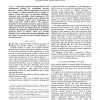Free Online Productivity Tools
i2Speak
i2Symbol
i2OCR
iTex2Img
iWeb2Print
iWeb2Shot
i2Type
iPdf2Split
iPdf2Merge
i2Bopomofo
i2Arabic
i2Style
i2Image
i2PDF
iLatex2Rtf
Sci2ools
DMIN
2006
2006
Structural Analysis and Destabilizing Terrorist Networks
This paper proposed structural analysis and mathematical methods for destabilizing terrorist networks. The three different approaches are discussed for example: (i) cohesion analysis (such as cliques, ncliques, n-clans and k-plex) to determine familiarity, robustness and reachability within subgroups in 9/11 terrorist network; (ii) role analysis (such as position role index) to determine critical nodes (gatekeepers or leaders) and their removal leads to the maximum disruption of the network; (iii) power analysis (such as degree centrality, Eigenvector centrality and dependence centrality) to uncover the hidden hierarchy of terrorist networks. The methods are implemented in the software prototype known as iMiner, which may provides assistance to law enforcement agencies, indicating when the capture of a specific terrorist will likely disrupt the terrorist network.
| Added | 30 Oct 2010 |
| Updated | 30 Oct 2010 |
| Type | Conference |
| Year | 2006 |
| Where | DMIN |
| Authors | Nasrullah Memon, Henrik Legind Larsen |
Comments (0)

